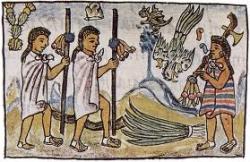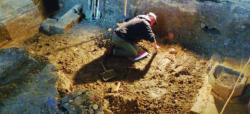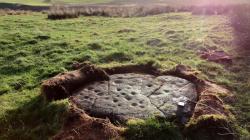INSTITUT SUPERIEUR D'ANTHROPOLOGIE
INSTITUTE OF ANTHROPOLOGY
ONLINE COURSES / COURS A DISTANCE
OPEN COURSE : FEBRUARY 2013
HRM 104 : INTRODUCTION TO INTANGIBLE CULTURAL HERITAGE
REGISTER NOW
MEXIQUE –  Codex de Florence - La Bibliothèque Numérique Mondiale est une alternative intéressante à la diffusion du patrimoine littéraire universel. C'est dans ce cadre que la Bibliothèque laurentienne a autorisé la numérisation de cet ouvrage si important pour les chercheurs sur le Mexique ancien. Il est désormais possible de consulter électroniquement le texte bilingue nahuatl-castillan et les illustrations qui accompagnaient chaque livre. Références : Bernardino de Sahagún (2012). Codex de Florence . [En ligne] Disponible sur : http://www.wdl.org/fr/item/10096/#q=Codex+de+Florence&view_type=list&search_page=1&qla=fr.
Codex de Florence - La Bibliothèque Numérique Mondiale est une alternative intéressante à la diffusion du patrimoine littéraire universel. C'est dans ce cadre que la Bibliothèque laurentienne a autorisé la numérisation de cet ouvrage si important pour les chercheurs sur le Mexique ancien. Il est désormais possible de consulter électroniquement le texte bilingue nahuatl-castillan et les illustrations qui accompagnaient chaque livre. Références : Bernardino de Sahagún (2012). Codex de Florence . [En ligne] Disponible sur : http://www.wdl.org/fr/item/10096/#q=Codex+de+Florence&view_type=list&search_page=1&qla=fr.
http://mexiqueancien.blogspot.fr/
INDE – Mendua - The 11th century embankment near Mendua village some six kilometers from Bhojpur considered a rare feat of engineering is close to be notified as a protected monument by the state government. It is part of the man-made bunds constructed during the 11{+t}{+h} century which shut outlet of water from surrounding hills of Kolans river surrounding Bhopal. According to Saxena, Mendua bears the hallmarks of the rare engineering feat of the Parmar Kings. "Near the Bhojpur temple, its purpose was to divert Kaliasot water to Betwa," she said. With the notification, all activity within 100 meters of the bund near the CRPF colony (Bhojpur) would be stopped and encroachments removed.
http://timesofindia.indiatimes.com/city/bhopal/Archaeology-dept-notifies-bund-near-Mendua-village-protected/articleshow/18422670.cms
FRANCE –  Caen - Fermée depuis septembre après l’apparition de nouvelles fissures sur la structure de sa tour-porche, l’église Saint-Jean est aujourd’hui méconnaissable. Tout autour du parvis intérieur, les équipes de l'Institut national de recherches archéologiques préventives (INRAP) sont à pied d'œuvre, à 1,30 mètre sous le sol. Un travail de fouilles de sauvetage avant les travaux nécessaires de stabilisation du bâtiment. Pour aller chercher une surface suffisamment stable, les cinquante-deux pieux qui soutiendront les poutres de l'église devront être implantés à 21 mètres de profondeur. Les archéologues doivent donc au préalable "prélever ce qui peut être sauvegardé." Comme il était attendu, des dizaines de squelettes ont été retrouvés dans le sous-sol. "Mais la surprise, c'est la découverte d'une série de pierres tombales très bien conservées du début du 14e siècle, dont deux recouvrent deux époux clairement identifiés, morts en 1317 et 1323. Il est d'ailleurs très probable qu'on en retrouve d'autres ailleurs dans l'église", explique l'archéologue François Delahaye. Les équipes ont trois semaines pour exhumer leurs trouvailles, qui seront, à terme, exposées aux Caennais.
Caen - Fermée depuis septembre après l’apparition de nouvelles fissures sur la structure de sa tour-porche, l’église Saint-Jean est aujourd’hui méconnaissable. Tout autour du parvis intérieur, les équipes de l'Institut national de recherches archéologiques préventives (INRAP) sont à pied d'œuvre, à 1,30 mètre sous le sol. Un travail de fouilles de sauvetage avant les travaux nécessaires de stabilisation du bâtiment. Pour aller chercher une surface suffisamment stable, les cinquante-deux pieux qui soutiendront les poutres de l'église devront être implantés à 21 mètres de profondeur. Les archéologues doivent donc au préalable "prélever ce qui peut être sauvegardé." Comme il était attendu, des dizaines de squelettes ont été retrouvés dans le sous-sol. "Mais la surprise, c'est la découverte d'une série de pierres tombales très bien conservées du début du 14e siècle, dont deux recouvrent deux époux clairement identifiés, morts en 1317 et 1323. Il est d'ailleurs très probable qu'on en retrouve d'autres ailleurs dans l'église", explique l'archéologue François Delahaye. Les équipes ont trois semaines pour exhumer leurs trouvailles, qui seront, à terme, exposées aux Caennais.
http://www.tendanceouest.com/caen/actualite-49022-des-pierres-tombales-en-sous-sol-de-eglise-saint-jean-a-caen.html?version=cherbourg
USA – Charleston - The mystery of the bones found at the Gaillard Auditorium construction site remains unsolved after a review of records dating back to the early 1800s. Two sets of human remains were discovered Monday during digging for a stormwater pipe trench near George and Anson streets. So far, age, gender and identity are unknown. No headstones, nails or other grave-related artifacts have been found. The Gaillard was built in the late 1960s, so the site has been covered for decades. The remains are buried head-to-toe, indicating they could be part of a larger and more formal graveyard spread out around the performing arts center. Bolstering that theory is the fact that both sets of remains are facing east, aligning with the Christian belief of positioning the dead so they can rise and receive the second coming of Christ, officials said.
http://www.postandcourier.com/article/20130208/PC16/130209302/1177/bones-at-gaillard-site-remain-a-mystery
ROYAUME UNI –  Swordale Hill - An archaeologist has uncovered the biggest collection of ancient rock art in the Highlands. Douglas Scott, 64, of Tain, Ross-shire, discovered a circle of 28 carved rocks which date back 5000 years while combing a 200-metre hillside farm in Evanton. Mr Scott reckons the stones, which have cup-marked shapes cut into them, represent one of the biggest collections of ancient rock art ever found in Scotland. These cup-marks are commonly known from other sites to be works of art carved out 5000 years ago. After studying the patterns on the rocks, Mr Scott published a report on his findings and has come to the conclusion that he has found one of the most significant ancient ritual centres in the country, where people used to worship the sun during midwinter sunrises. Mr Scott said: "I've been looking at rock art over the whole Scotland for the last 30 years and these things are the expression of the beliefs people had 4000 to 5000 years ago."The rocks on Swordale Hill all align to where the sun and moon rises and sets in midwinter, which is no coincidence.
Swordale Hill - An archaeologist has uncovered the biggest collection of ancient rock art in the Highlands. Douglas Scott, 64, of Tain, Ross-shire, discovered a circle of 28 carved rocks which date back 5000 years while combing a 200-metre hillside farm in Evanton. Mr Scott reckons the stones, which have cup-marked shapes cut into them, represent one of the biggest collections of ancient rock art ever found in Scotland. These cup-marks are commonly known from other sites to be works of art carved out 5000 years ago. After studying the patterns on the rocks, Mr Scott published a report on his findings and has come to the conclusion that he has found one of the most significant ancient ritual centres in the country, where people used to worship the sun during midwinter sunrises. Mr Scott said: "I've been looking at rock art over the whole Scotland for the last 30 years and these things are the expression of the beliefs people had 4000 to 5000 years ago."The rocks on Swordale Hill all align to where the sun and moon rises and sets in midwinter, which is no coincidence.
http://news.stv.tv/highlands-islands/213064-archaeologist-uncovers-one-of-the-biggest-collections-of-rock-art/